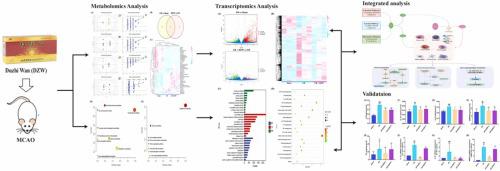Biomedicine & Pharmacotherapy ( IF 6.9 ) Pub Date : 2022-09-19 , DOI: 10.1016/j.biopha.2022.113703 Jing-Yi Hou 1 , Guang-Zhao Cao 2 , Liang-Liang Tian 2 , Rui Zhou 2 , Yi Zhang 2 , He Xu 2 , Hong-Wei Wu 2 , Li-Fang Wang 2 , Hong-Jun Yang 1 , Jing-Jing Zhang 3

|
Background/Aims
Duzhi Wan (DZW) has been extensively used in the prevention and treatment of ischemic stroke, but the mechanisms underlying its effects remain unclear. In this study, a combination of transcriptomics, metabolomics and network analysis was applied to identify the preventive mechanism of DZW in middle cerebral artery occlusion (MCAO)-induced ischemia/reperfusion (I/R) injury.
Methods
The mice were divided into five groups: the sham group, I/R group, I/R + Ginaton group, I/R+DZW-L group, and I/R+DZW-H group. Neurological deficit scores and regional cerebral blood flow (rCBF), hematoxylin and eosin (H&E) and Nissl staining results were evaluated. Transcriptomics analysis and metabolomics analysis were applied to identify the key genes and metabolites, and qRT-PCR, ELISA, and immunofluorescence were applied to verify the key targets.
Results
DZW significantly decreased the infarction size and neurological deficit scores, increased the rCBF percentage and neuronal number and improved neuronal morphology after MCAO. Transcriptomics and metabolomics analysis revealed that C3 and C5ar1 were core targets of DZW and indirectly regulated downstream purine metabolism, the pentose phosphate pathway, and glycerophospholipid metabolism-associated pathways via inflammatory cells. Moreover, ELISA, qRT-PCR, and immunofluorescence further confirmed that DZW significantly decreased the expression of C3, C5ar1, C5 and downstream inflammatory cytokines, including IL-6, IL-1β and MMP-9, at the gene and protein levels, suggesting that DZW decreased neuroinflammation and inhibited related metabolic pathways.
Conclusion
C3 and C5 play important roles in the neuroprotective and antineuroinflammatory effects of DZW in protecting against cerebral I/R. This study provides novel insights into the neuroprotective effects of DZW and its clinical application.
中文翻译:

整合转录组学和代谢组学分析表明,C3和C5是独致丸保护脑缺血损伤的重要靶点
背景/目标
独致丸 (DZW) 已广泛用于缺血性脑卒中的预防和治疗,但其作用机制尚不清楚。在这项研究中,结合转录组学、代谢组学和网络分析来确定 DZW 在大脑中动脉闭塞 (MCAO) 诱导的缺血/再灌注 (I/R) 损伤中的预防机制。
方法
将小鼠分为5组:sham组、I/R组、I/R+Ginaton组、I/R+DZW-L组、I/R+DZW-H组。评估神经功能缺损评分和局部脑血流量 (rCBF)、苏木精和伊红 (H&E) 以及 Nissl 染色结果。转录组学分析和代谢组学分析用于鉴定关键基因和代谢物,并应用qRT-PCR、ELISA和免疫荧光验证关键靶点。
结果
DZW 显着降低了梗死面积和神经功能缺损评分,增加了 rCBF 百分比和神经元数量,并改善了 MCAO 后的神经元形态。转录组学和代谢组学分析表明,C3 和 C5ar1 是 DZW 的核心靶点,并通过炎症细胞间接调节下游嘌呤代谢、戊糖磷酸途径和甘油磷脂代谢相关途径。此外,ELISA、qRT-PCR 和免疫荧光进一步证实,DZW 在基因和蛋白质水平上显着降低 C3、C5ar1、C5 和下游炎性细胞因子(包括 IL-6、IL-1β 和 MMP-9)的表达,提示表明 DZW 减少了神经炎症并抑制了相关的代谢途径。
结论
C3 和 C5 在 DZW 预防脑 I/R 的神经保护和抗神经炎症作用中起重要作用。本研究为 DZW 的神经保护作用及其临床应用提供了新的见解。











































 京公网安备 11010802027423号
京公网安备 11010802027423号